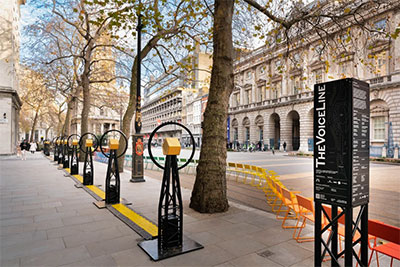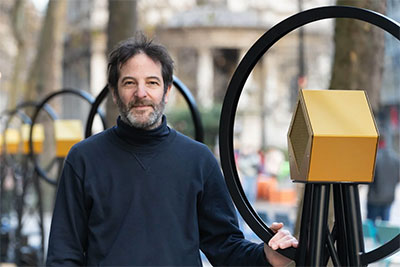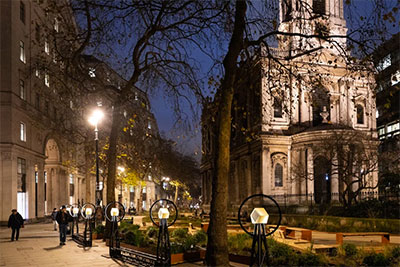![]() The centenary of the BBC’s first radio transmission saw sound artist Nick Ryan invited to submit a proposal for an installation drawing on the the exchange of ideas, education and art appreciation offered by a well-travelled common space.
The centenary of the BBC’s first radio transmission saw sound artist Nick Ryan invited to submit a proposal for an installation drawing on the the exchange of ideas, education and art appreciation offered by a well-travelled common space.
‘I was the only artist that suggested sound,’ he recalls. ‘My idea was to use sound in a controlled way. I wanted the soundscape to change every second or every minute, and use a long speaker array to animate the space through sound.’
Located along a recently pedestrianised stretch of The Strand in Central London, the aim was to ‘take back’ an area notoriously congested with traffic and noise pollution by converting it into an environmentally friendly, culturally inviting space. A major thoroughfare in the City of Westminster, The Strand was the principal route between the separate settlements of the City of London during the Middle Ages. Running alongside the north bank of the Thames, it has long been a processionary route and is now a major London thoroughfare.
The BBC’s broadcast was made from Marconi House on 11 May 1922 at 857kHz, which corresponds to a wavelength of 350m – which is reflected in the shape of the VoiceLine walk.
 After creating and testing several prototypes, Ryan created a linear sound array featuring 39 L-Acoustics 5XT coaxial speakers – each 3.5m apart and set along a path within the newly pedestrianised quarter. Powering the array are ten L-Acoustics LA4X four-channel amplified controllers, each connected to an AVB network where they can be independently controlled.
After creating and testing several prototypes, Ryan created a linear sound array featuring 39 L-Acoustics 5XT coaxial speakers – each 3.5m apart and set along a path within the newly pedestrianised quarter. Powering the array are ten L-Acoustics LA4X four-channel amplified controllers, each connected to an AVB network where they can be independently controlled.
Among 15 artists who were asked to make a proposal for the installation, Ryan is also one of 70 artists in residence at London’s Somerset House. Located directly across the street from Somerset House, pedestrians can enter Ryan’s VoiceLine at any point along the 170m path and experience bespoke soundscapes throughout the day and into the evening. The installation is also visually stunning, featuring custom brass loudspeaker enclosures that Ryan designed while protecting them from the elements. Encircling each enclosure is a ‘light ring’ that is triggered whenever a sound is produced, adding a visual aspect to the multi-sensory experience.
‘At night, they light up, indicating the behaviour of the sound and they look really beautiful,’ Ryan says.
Since the VoiceLine opened, Ryan has experimented with several different soundscapes. The recorded material is sourced from a variety of places, including his own sound library of environmental recordings and compositions, other commissioned artists’ work, as well as the entire BBC Audio Archive. The programming schedule itself is driven by various factors, including the time of day and the profile of typical pedestrian traffic.
‘One use case is that a pedestrian may start at one end and walk the entire route; we can exploit that journey in narrative form,’ Ryan says. ‘Some programmes move at walking pace, and other pieces of music travel up and down the path quite rapidly.’
Examples of content that visitors may hear along the journey include ‘theatreland,’ consisting of cast recordings Ryan has made during Mamma Mia warm-ups, and espionage broadcasts from the past 50 years.
‘As it gets darker, we can get more experimental,’ he explains.
 In several of his VoiceLine broadcasts, Ryan has used on L-ISA Studio to give him an added measure of control – particularly over elements such as panning and reverb.
In several of his VoiceLine broadcasts, Ryan has used on L-ISA Studio to give him an added measure of control – particularly over elements such as panning and reverb.
‘VoiceLine is basically the unfolding of an immersive system into a line, and L-ISA Studio was instrumental in making the experience seamless. The idea is to create a “bubble of sound” that precisely overlaps each subsequent bubble of sound, and L-ISA Studio helps me render this seamlessly.’
The loudspeakers are set in a ‘crisscross’ pattern, with audio played at a relatively low level, so there is no break in the linearity. ‘We get a very high-fidelity sound from the L-Acoustics speakers and using these in combination with the L-ISA Studio software, the fixed points of each speaker become imperceptible. The perfect overlap between each sound source makes it a continuous experience.’
When he is composing and mixing some of the more challenging pieces broadcast across the VoiceLine, Ryan adds space and dimension using L-ISA Studio: ‘I love the immersive reverb,’ he says. ‘If I had time, I would use that reverb for everything because it gives this incredible richness to any sound source. It is genuinely modelled, and it sounds so different.’
Ryan also appreciates the software’s powerful panning and rotation faculties: ‘Movement from one speaker to the next is seamless, and the rotation function can be very useful when you want to move an object a full 180° – this capability doesn’t exist in other immersive tools.’
 One of Ryan’s favourite pieces to play through the system is a quadraphonic recording of a family of whales made by his colleague Michelle Fournet, a leading marine acoustic ecologist. The pair collaborated on Fathom, film about how humpback whales communicate, and Ryan subsequently received an Emmy for his sound design work.
One of Ryan’s favourite pieces to play through the system is a quadraphonic recording of a family of whales made by his colleague Michelle Fournet, a leading marine acoustic ecologist. The pair collaborated on Fathom, film about how humpback whales communicate, and Ryan subsequently received an Emmy for his sound design work.
‘I’ve unfolded those whale recordings in L-ISA Studio, put a church reverb on them, and I have Michelle’s narration with no reverb in the middle speaker – it sounds incredible. Her voice is really clear, and you can hear it without any comb filtering, even though the same signal is coming out of five speakers on either side. Then there are these whales swimming around, making their noises down a line of eight along the street. It is incredible.’
For his recordings of the cast of Mamma Mia warming up, which can be heard on the VoiceLine installation during programmes in the afternoon, Ryan put the multitrack recording into L-ISA Studio and widened each sound object a little bit, using the panning controls and applied the program’s ‘theatre’ reverb. The result, he says, has ‘incredible spatial depth, amazing’.
One of the reasons that the VoiceLine is inspiring for Ryan is that sound is an innate form of human perception, rooted inextricably in our evolution. ‘Sound is our primary form of communication,’ he observes. ‘Before the full visual representation of meaning and language, our species relied on sound for its culture than anything else.’